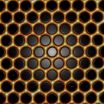(Press-News.org) Menlo Park, Calif. — Researchers from Stanford University and the U.S. Department of Energy's SLAC National Accelerator Laboratory have created the first-ever system of "designer electrons" – exotic variants of ordinary electrons with tunable properties that may ultimately lead to new types of materials and devices.
"The behavior of electrons in materials is at the heart of essentially all of today's technologies," said Hari Manoharan, associate professor of physics at Stanford and a member of SLAC's Stanford Institute for Materials and Energy Sciences, who led the research. "We're now able to tune the fundamental properties of electrons so they behave in ways rarely seen in ordinary materials."
Their first examples, reported today in Nature, were hand-crafted, honeycomb-shaped structures inspired by graphene, a pure form of carbon that has been widely heralded for its potential in future electronics. Initially, the electrons in this structure had graphene-like properties; for example, unlike ordinary electrons, they had no mass and traveled as if they were moving at the speed of light in a vacuum. But researchers were then able to tune these electrons in ways that are difficult to do in real graphene.
To make the structure, which Manoharan calls molecular graphene, the scientists use a scanning tunneling microscope to place individual carbon monoxide molecules on a perfectly smooth copper surface. The carbon monoxide repels the free-flowing electrons on the copper surface and forces them into a honeycomb pattern, where they behave like graphene electrons.
To tune the electrons' properties, the researchers repositioned the carbon monoxide molecules on the surface; this changed the symmetry of the electron flow. In some configurations, electrons acted as if they had been exposed to a magnetic or electric field. In others, researchers were able to finely tune the density of electrons on the surface by introducing defects or impurities. By writing complex patterns that mimicked changes in carbon-carbon bond lengths and strengths in graphene, the researchers were able to restore the electrons' mass in small, selected areas.
"One of the wildest things we did was to make the electrons think they are in a huge magnetic field when, in fact, no real field had been applied," Manoharan said. Guided by the theory developed by co-author Francisco Guinea of Spain, the Stanford team calculated the positions where carbon atoms in graphene should be to make its electrons believe they were being exposed to magnetic fields ranging from zero to 60 Tesla, more than 30 percent higher than the strongest continuous magnetic field ever achieved on Earth. The researchers then moved carbon monoxide molecules to steer the electrons into precisely those positions, and the electrons responded by behaving exactly as predicted – as if they had been exposed to a real field.
VIDEO:
This video shows carbon monoxide molecules (black circles) being moved one at a time by a scanning tunneling microscope into the hexagonal "molecular graphene " arrangement. The molecules repel the free-flowing...
Click here for more information.
"Our new approach is a powerful new test bed for physics," Manoharan said. "Molecular graphene is just the first in a series of possible designer structures. We expect that our research will ultimately identify new nanoscale materials with useful electronic properties."
INFORMATION:
Additional authors included Kenjiro K. Gomes, Warren Mar and Wonhee Ko of the Stanford Institute for Material and Energy Sciences. Francisco Guinea is a researcher at the Madrid Materials Science Institute. The research was supported by the U.S. Department of Energy's Office of Basic Energy Sciences, the National Science Foundation and the Spanish Ministry of Science & Innovation.
Multimedia relating to this research is available for download at: http://mota.stanford.edu/molecular_graphene.php
SLAC is a multi-program laboratory exploring frontier questions in photon science, astrophysics, particle physics and accelerator research. Located in Menlo Park, California, SLAC is operated by Stanford University for the U.S. Department of Energy Office of Science. To learn more, please visit www.slac.stanford.edu.
DOE's Office of Science is the largest supporter of basic research in the physical sciences in the United States, and is working to address some of the most pressing challenges of our time. For more information, please visit science.energy.gov.
Molecular graphene heralds new era of 'designer electrons'
2012-03-15
ELSE PRESS RELEASES FROM THIS DATE:
Many Jobless Turning to Social Security When Unemployment Ends
2012-03-15
Families throughout the nation continue to struggle financially. In fact, the prospect of economic stability continues to look so grim professionals have coined this period of time the Great Recession. Many depend on unemployment benefits to make ends meet during these difficult times, but what happens when they run out?
Now, more and more people are looking to Social Security Disability benefits when their unemployment ends. Whether people were disabled before their unemployment began or became disabled while receiving unemployment, Social Security Disability offers ...
Collaborative preclinical efficacy studies suggest a new target for drug addiction treatment
2012-03-15
In preclinical studies, researchers at SRI International and Astraea Therapeutics have recently evaluated the role of a new drug receptor target that shows promise for the treatment of drug addiction.
This potential new drug target belongs to a class of receptors called the nicotinic acetylcholine receptors (nAChRs). One subtype of nAChRs, called alpha4beta2 is a well-known target for nicotine's addictive effects and the therapeutic effect of the smoking cessation drug varenicline. SRI researchers are now studying another, lesser-known subtype, called alpha3beta4 nAChR, ...
What to Do When Nursing Home Neglect Leads to Dangerous Dehydration
2012-03-15
Dehydration is one of the most common forms of nursing home neglect. The risk of dehydration is particularly acute in patients who suffer from health problems that render them incapable of properly communicating their needs.
Nursing home dehydration can happen for a number of different reasons. Some patients aren't physically able to drink from a glass, either because they have difficulty swallowing or because they are unable to sit upright. In other cases, patients with cognitive or emotional difficulties may refuse certain beverages. In the worst cases the neglect ...
More than half of Americans doubt US global leadership in 2020
2012-03-15
WASHINGTON—March 14, 2012—More than half of likely voters doubt that the United States will be the No. 1 world leader in science, technology and health care by the year 2020, according to a new national public opinion poll commissioned by Research!America. The findings reveal deep concerns among Americans about the country's ability to maintain its world-class status in innovation, research and development before the next decade.
"A lackluster investment in science and innovation is driving fears among Americans about our world dominance in the years ahead," said Research!America ...
Study demonstrates cells can acquire new functions through transcriptional regulatory network
2012-03-15
Researchers at the RIKEN Omics Science Center (OSC) have successfully developed and demonstrated a new experimental technique for producing cells with specific functions through the artificial reconstruction of transcriptional regulatory networks. As an alternative to induced pluripotent stem cells, the technique promises to enable faster and more efficient production of functional cells for use in cancer therapy and a variety of other areas.
Starting with the first-ever production of induced pluripotent stem cells (iPS cells) in 2006, cell reprogramming - the genetic ...
Genome-wide study reveals how key immune sensors arrive at the front lines of infection
2012-03-15
LA JOLLA, Calif., March 14, 2012 – In a healthy immune system, invading pathogens trigger a cascade of alerts and responses to fight off the infection. Sensors called toll-like receptors, or TLRs, act as one of the first lines of defense. Two of these sensors, known as TLR7 and TLR9, specifically recognize and respond to microbial RNA and DNA, respectively. But what determines how these TLRs get where they need to be and sound the alarm for pathogen infection? To answer this question, a team led by Sumit Chanda, Ph.D. and colleagues at Sanford-Burnham Medical Research Institute ...
Breakthroughs in Chikungunya research from A*STAR spell new hope for better treatment and protection
2012-03-15
Recent breakthroughs in Chikungunya research spearheaded by scientists at A*STAR's Singapore Immunology Network (SIgN) have made great strides in the battle against the infectious disease. Working in close collaborations with Singapore clinician-scientists and international researchers , Dr Lisa Ng, Principal Investigator of the Chikungunya research group at SIgN, led the team to discover a direct biomarker which serves as an early and accurate prognosis of patients who have a higher risk of the more severe form of Chikungunya fever (CHIKF). This means that doctors can ...
Texas Paternity Fraud: I'm Not the Father So Why the Child Support?
2012-03-15
What if a man has been named the father of a child, but has to pay child support because he missed court or was misled into signing a paternity statement without a DNA test? Although the Texas Family Code covers a wide range of legal issues from divorce, child custody and spousal support to modifications of custody and visitation because of parental relocation, one Texas paternity provision was recently changed regarding the need to correct paternity mistakes with DNA testing.
Prior to the passage of Texas Senate Bill 785, a man could only request a paternity test prior ...
UN emission market needs urgent reform
2012-03-15
The United Nations (UN) global carbon market requires substantial reform because it too often fails to support the projects and people it is meant to help, according to new research from the Economic and Social Research Council (ESRC).
The research findings are released as the UN, which has designated 2012 the International Year of Sustainable Energy for All, begins a policy dialogue about its Clean Development Mechanism (CDM), under which companies are allocated tradable credits if they pay others to cut their carbon emissions.
The CDM is designed to help finance ...
Anesthetists test scale that measures risk of harm from invasive research placebos
2012-03-15
A scale developed to measure the potential harm caused by invasive placebos in local anaesthesia research has been successfully tested by a group of 43 independent clinicians, according to research published in the April issue of Anaesthesia.
The consultant anaesthetists were asked to assess the risk of harm posed by control group interventions described in ten published clinical anaesthesia studies using the Serious Harm and Morbidity (SHAM) scale.
There was substantial agreement between the 22 consultants who were given clinical examples to illustrate the scale ...

